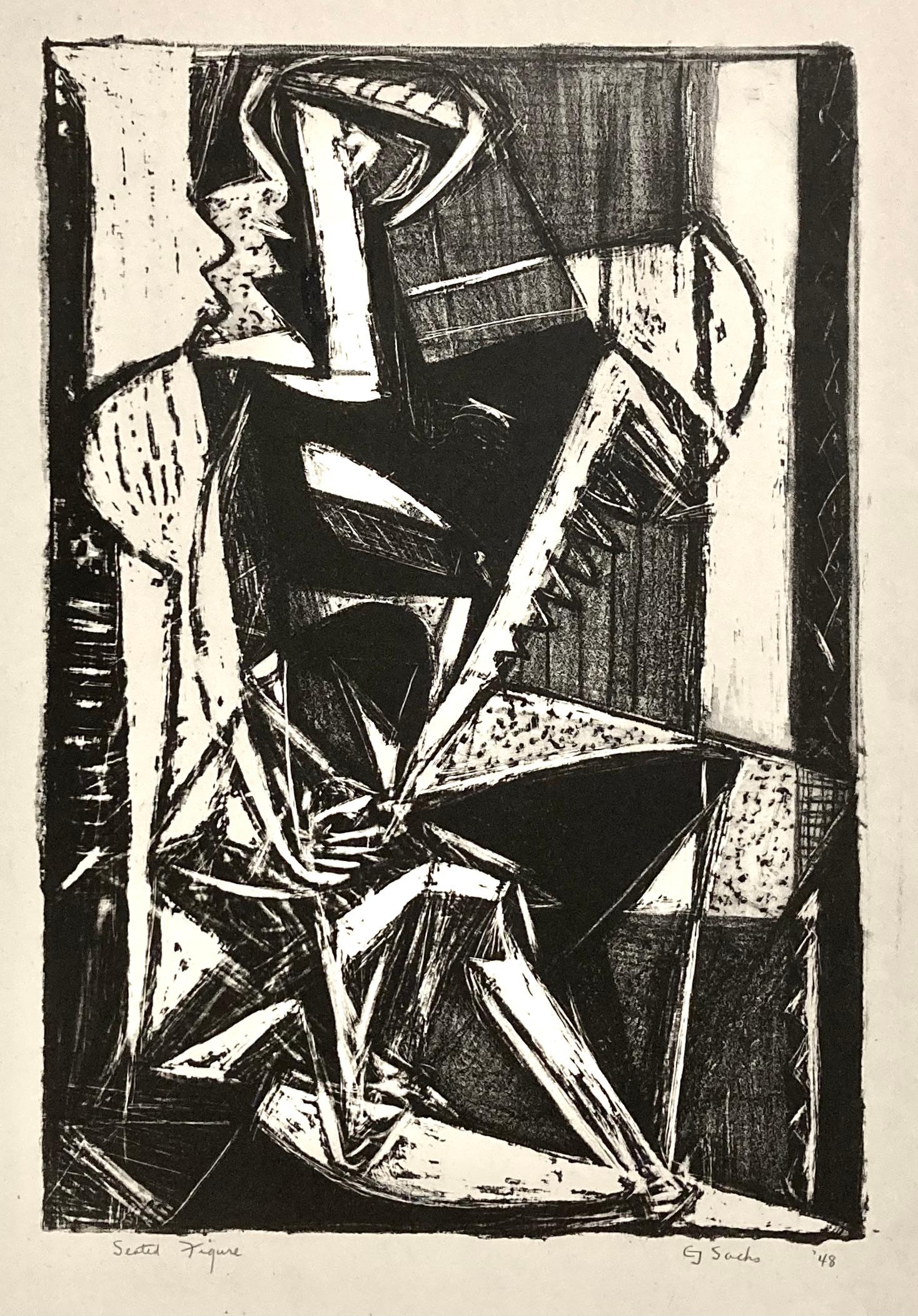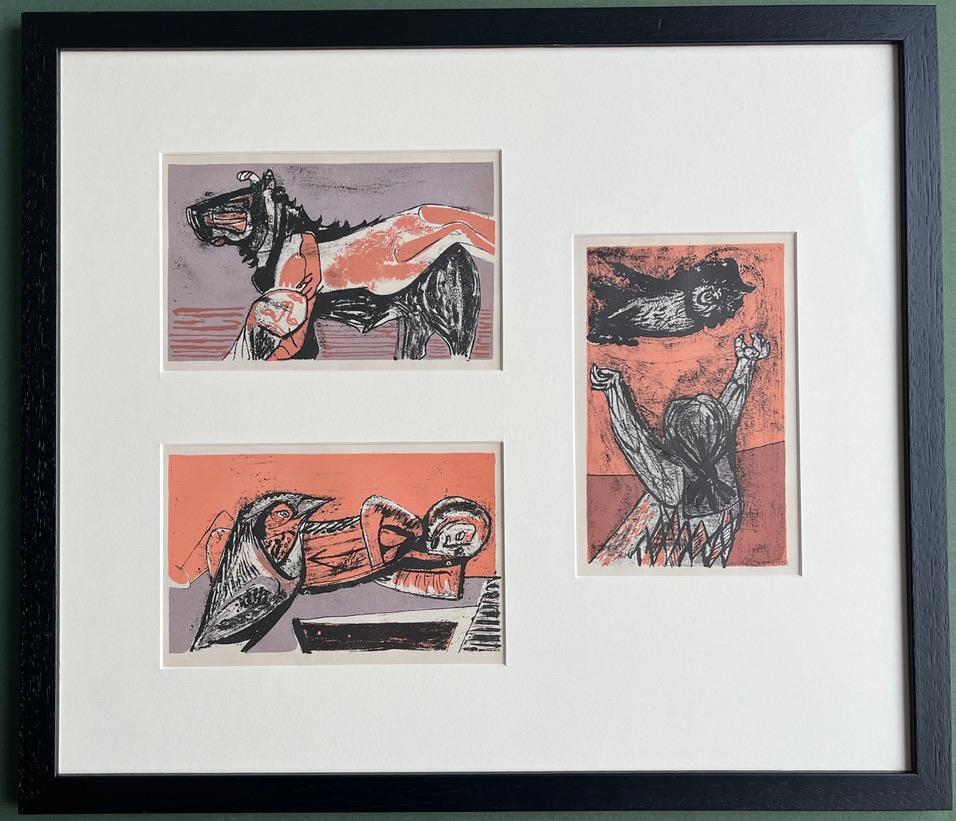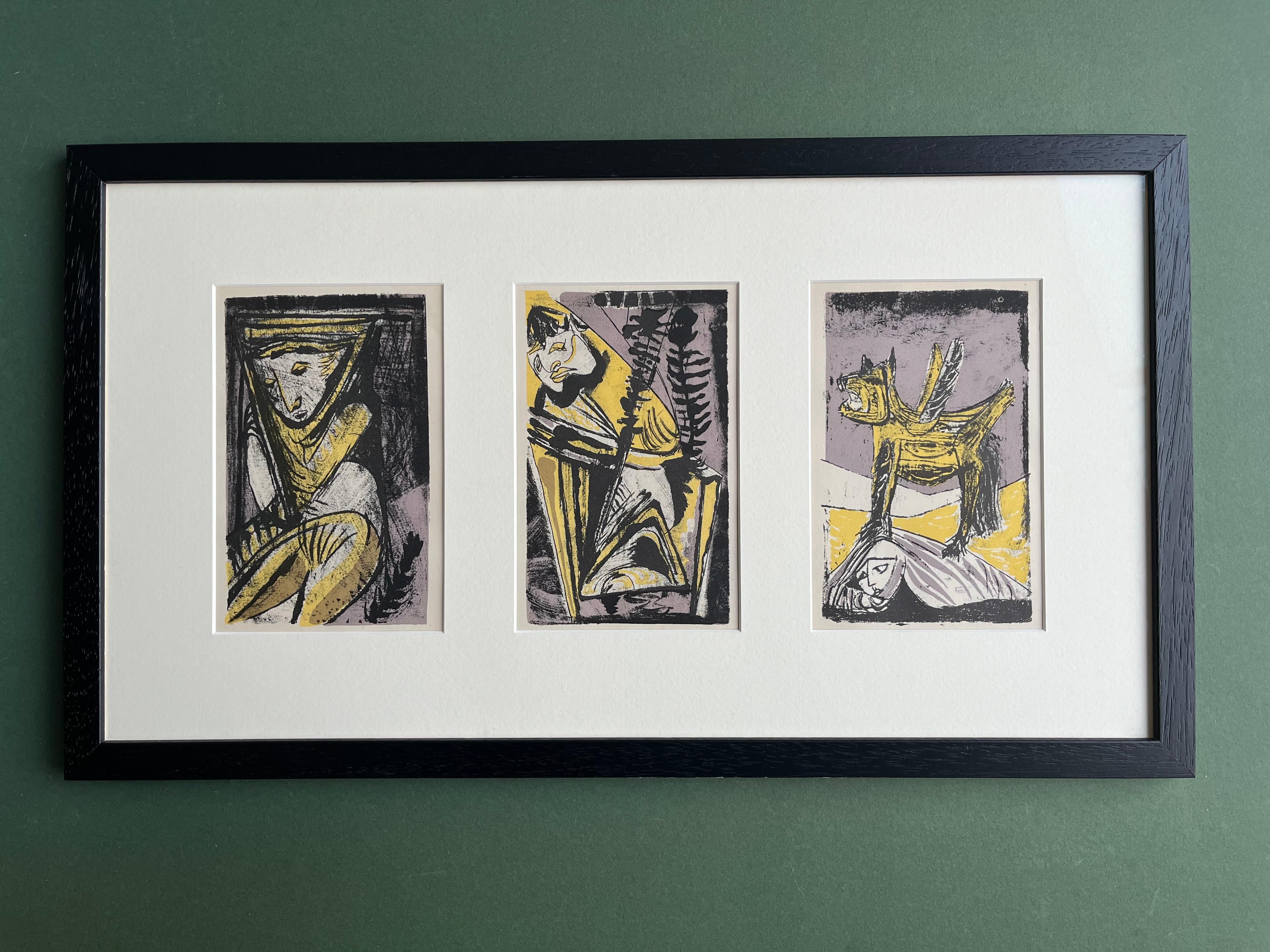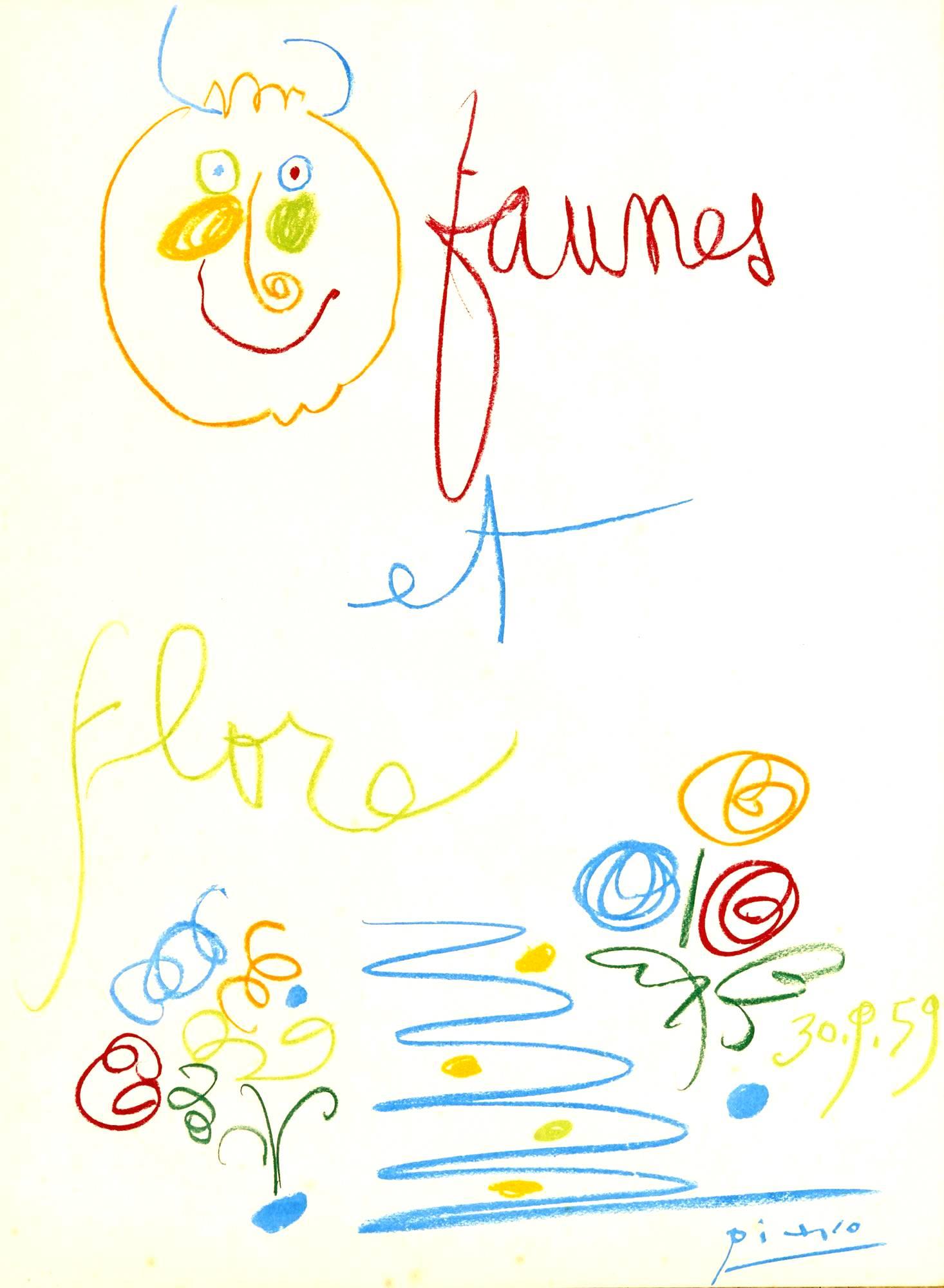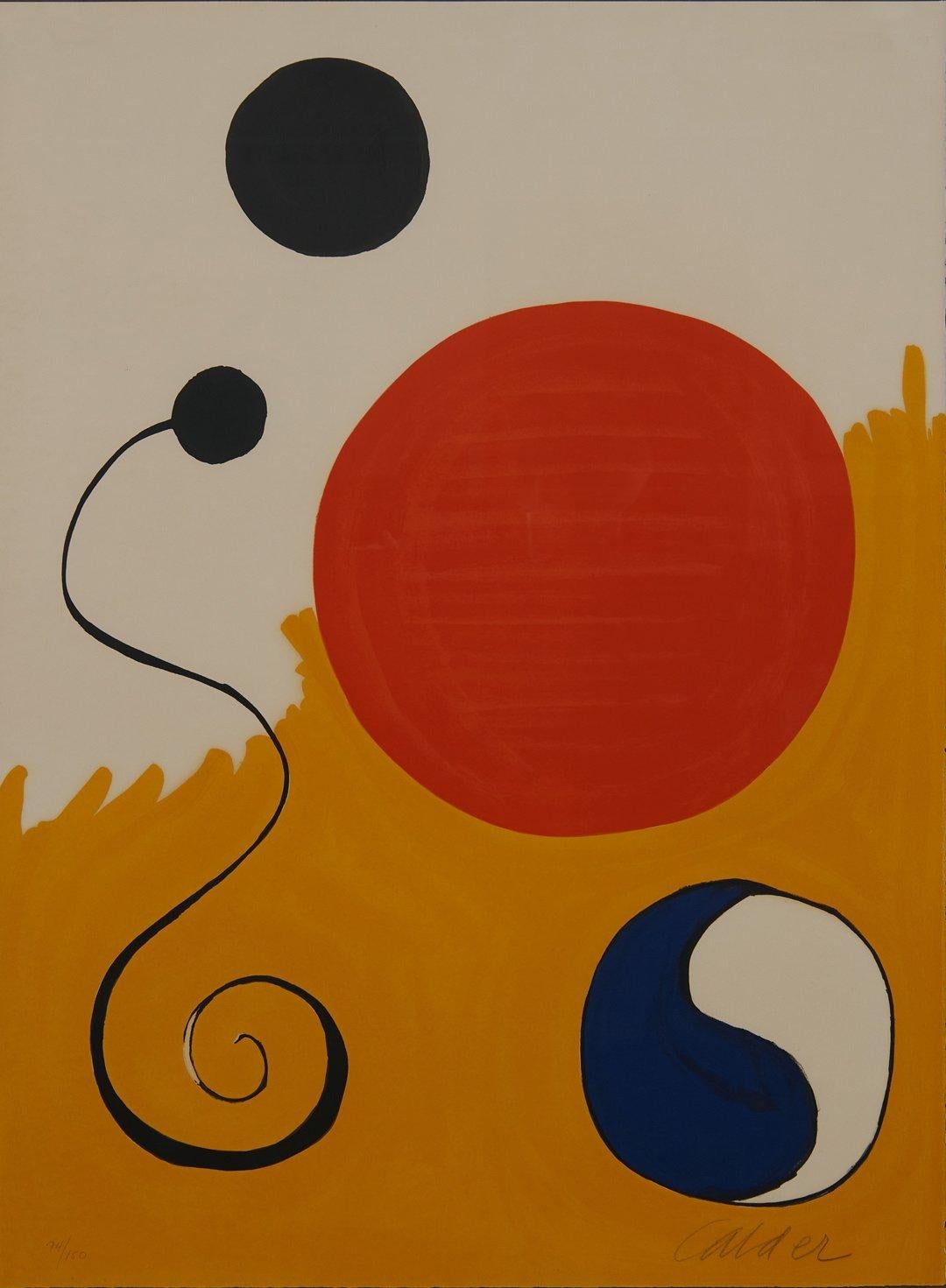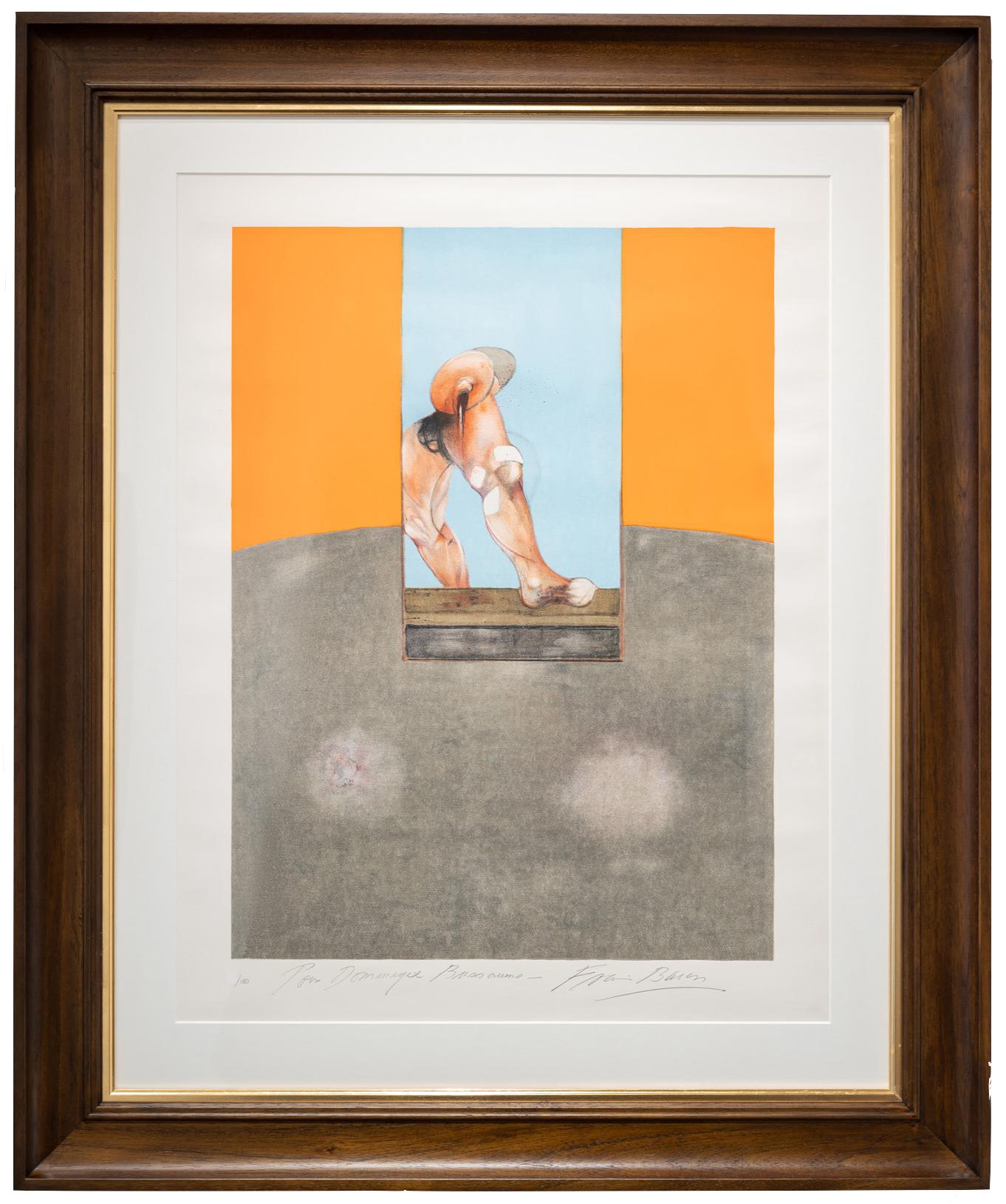Items Similar to Pablo Picasso Estate Hand Signed French Cubist Lithograph Abstract Portrait Tete
Want more images or videos?
Request additional images or videos from the seller
1 of 12
(after) Pablo PicassoPablo Picasso Estate Hand Signed French Cubist Lithograph Abstract Portrait Tete
About the Item
Pablo Picasso (after)
"Tete"
limited edition print on Arches paper,
Hand signed by Marina Picasso lower right and numbered 195/500 lower left
From the estate of Pablo Picasso with an embossed blindstamp in the lower right side of the piece.
After Pablo Picasso's death in 1973, his granddaughter Marina authorized the printing of these original lithographs, which have come to be known as the Picasso Estate Collection. The lithographs were meticulously created after the original works (Oil Paintings, Watercolors, Pastels, Charcoal Drawings, etc.) by Master Chromist Marcel Salinas, who worked closely with Picasso in his lifetime. They are printed in an edition of 500 on Arches paper. Embossed with the estate and chromist's stamp seals, along with the legend on the reverse "Approved by the heirs of Pablo Picasso".
Image: 21 1/2" x 17 1/2". Paper: 29 1/2" x 22".
Pablo Ruiz Picasso (1881 – 1973) was a Spanish painter, sculptor, printmaker, ceramicist, stage designer, poet and playwright who spent most of his adult life in France. Regarded as one of the most influential artists of the 20th century, he is known for co-founding the Cubist movement, the invention of constructed sculpture, the co-invention of collage, and for the wide variety of styles that he helped develop and explore. Among his most famous works are the proto-Cubist Les Demoiselles d'Avignon (1907), and Guernica (1937), a dramatic portrayal of the bombing of Guernica by the German and Italian air forces during the Spanish Civil War.
Picasso demonstrated extraordinary artistic talent in his early years, painting in a naturalistic manner through his childhood and adolescence. During the first decade of the 20th century, his style changed as he experimented with different theories, techniques, and ideas. After 1906, the Fauvist work of the slightly older artist Henri Matisse motivated Picasso to explore more radical styles, beginning a fruitful rivalry between the two artists, who subsequently were often paired by critics as the leaders of modern art.
Picasso's work is often categorized into periods. While the names of many of his later periods are debated, the most commonly accepted periods in his work are the Blue Period (1901–1904), the Rose Period (1904–1906), the African-influenced Period (1907–1909), Analytic Cubism (1909–1912), and Synthetic Cubism (1912–1919), also referred to as the Crystal period. Much of Picasso's work of the late 1910s and early 1920s is in a neoclassical style, and his work in the mid-1920s often has characteristics of Surrealism. His later work often combines elements of his earlier styles.
In 1907, Picasso joined an art gallery that had recently been opened in Paris by Daniel-Henry Kahnweiler. Kahnweiler was a German art historian and art collector who became one of the premier French art dealers of the 20th century. He was among the first champions of Pablo Picasso, Georges Braque and the Cubism that they jointly developed. Kahnweiler promoted burgeoning artists such as André Derain, Kees van Dongen, Fernand Léger, Juan Gris, Maurice de Vlaminck and several others who had come from all over the globe to live and work in Montparnasse at the time.Picasso participated in the School Prints, to bring art to the masses in the 1940's. A magnificent European series, made possible by plastic portable plates, which, in addition to Henry Moore, featured Henri Matisse, Pablo Picasso, Fernand Leger, Raoul Dufy and Georges Braque.
- Creator:(after) Pablo Picasso (1881 - 1973, Spanish)
- Dimensions:Height: 22 in (55.88 cm)Width: 29.5 in (74.93 cm)
- Medium:
- Movement & Style:
- Period:
- Condition:good. never framed. very minor wear. please see photos.
- Gallery Location:Surfside, FL
- Reference Number:1stDibs: LU38211475632
About the Seller
4.9
Platinum Seller
These expertly vetted sellers are 1stDibs' most experienced sellers and are rated highest by our customers.
Established in 1995
1stDibs seller since 2014
1,547 sales on 1stDibs
Typical response time: 1 hour
- ShippingRetrieving quote...Ships From: Surfside, FL
- Return PolicyA return for this item may be initiated within 3 days of delivery.
More From This SellerView All
- Large Venezuelan Modernist Lithograph "The Balcony #3" Color PrintBy Marius SznajdermanLocated in Surfside, FLMarius Sznajderman was a painter, printmaker and scenic designer living and working in the United States. Born in Paris, France in 1926 his Jewish parents had migrated to France from Poland in 1923. In November 1942 the family fled Nazi-occupied France for Spain before settling in Caracas, Venezuela. He attended the School of Fine Arts in Caracas where his teachers included illustrator Ramon Martin Durban, scenic designer Charles Ventrillon-Horber and painter Rafael Monasterios. and immigrated to the United States in 1949, where he received a Bachelor of Fine Arts and Master of Fine Arts from Columbia University in New York. He settled in Hackensack, New Jersey, where he lived and had a studio for more than 50 years before moving to Amherst, Massachusetts in 2015. His work, which includes painting, prints and collages, as well as set designs, is in more than 45 museum and public institution collections in the United States, Latin America and Israel. He held more than 40 solo exhibitions at galleries and museums and participated in more than 75 group shows around the globe. He helped found the Taller Libre de Arte, an experimental workshop for the visual arts, sponsored by the Ministry of Education. The Taller Libre de Arte was a center for young artists to work and to meet with critics and intellectuals to discuss avant-garde ideas and artistic trends from Europe and Latin America. Among the notable artists who participated in the Taller Libre de Arte were Ramón Vásquez Brito, Carlos González Bogen, Luis Guevara Moreno, Mateo Manaure, Virgilio Trómpiz...Category
20th Century Modern Figurative Prints
MaterialsLithograph
- French Modernist Mourlot Lithograph Vintage Air France Poster Roger BezombesBy Roger BezombesLocated in Surfside, FLVintage French Travel Poster, Air france Roger Bezombes (1913-1994) French Bezombes was a painter, sculptor, medalist, and designer. He studied in Paris, at the École des Beaux-Arts, and was much influenced by his friendship with Maurice Denis. Heavily influenced by surrealism, He worked principally as a painter, adopting the saturated Fauvist colors of Henri Matisse in landscapes and figure studies often based on observation of “exotic” cultures, notably Mediterranean and North African. Constrained, because a very young orphan, to all kinds of professions which provide him with the material means to devote himself to painting - he participated in 1930 in the installation of the exhibition of the Bauhaus at the Grand Palais-, Roger Bezombes is student of the National School of Fine Arts in Paris. (Ecole des Beaux Artes) He was trained in the art of fresco by Paul Baudoüin, René Barotte nonetheless restores that the young man's preference goes to the practice of "truancy" which he uses to make copies at the Louvre Museum. It’s the time when Paul Gauguin’s paintings, Vincent Van Gogh and Henri Matisse are revealed to him by Maurice Denis with whom he will remain close until his accidental death, painting him on his funeral bed on November 14, 1943. He executed surrealist tapestry designs for Aubusson and Gobelin tapestries, posters (winning the Grand Prix de l'Affiche Francaise in 1984), costumes and sets for ballets at the Metropolitan Opera House in New York, reliefs and murals. In 1965 he took up medal-making, expressing in his numerous metallic works for the Paris Mint that obsession with found objects which is also evident in his large-scale sculpture and in his posters. He designed posters for Air France and for the French national railways. Roger Bezombes went to Africa for the first time in 1936 thanks to a travel grant and received the same year the second grand prize of Rome . In 1937 he traveled around Morocco where he became friends with Albert Camus. The year 1938 offered him both his first solo exhibition at the Charpentier gallery in Paris with paintings and gouaches on the theme of Morocco and the attribution of the national grand prize for the arts, earning him a great journey which , from Dakar to Algiers , takes it through Chad , Tamanrasset and Hoggar. Roger Bezombes became a professor at the Julian Academy in 1950. For him, 1951 was the year of a trip to Greece and the year where he began his relationship with tapestry work. Roger Bezombes visited Israel in 1953, Tunisia and Egypt in 1954. He was appointed official painter of the Navy in 1955. Pierre Mazars analyzes that “after a period where we notice the influence of Van Gogh and GeorgesBraque, particularly in his landscapes of Provence, he came to a more schematic writing, the colored spots and the thicknesses of material taking more of importance as the subject. He even performed composite works, half-watercolors, half-pasted papers, in which he incorporated pieces of newspapers”. He was elected titular to the Academy of Overseas Sciences in 1978. "The range of Bezombes' talent forms is remarkable,” writes Lynne Thornton, “ranging from paintings, murals, travel posters, tapestry cartons, book illustrations, monumental ceramic decorations, ballet and theater sets, totem sculptures, sculpture objects, jewelry and medallions”. He was part of the mid century mod School of Paris that included Leon Zack, Bernard Lorjou, Paul Augustin Aizpiri, Gabriel Godard, Michel Henry, Hans Erni, Bengt Lindstrom, Alfred Manessier, Andre Hambourg, Raymond Legueult and Jean Rigaud. Select Solo Exhibitions: 1938: Galerie Charpentier, Paris 1950, '53, '55, '57: Galerie Andre Weil, Paris 1953:Wildenstein Gallery, London 1954: Institut Francais, Cologne 1956: Galerie Matarasso, Nice 1957: Horn Gallery, Luxembourg; Guilde de la Gravure, Paris 1958: Denys-Puech Museum, Rodez 1962: Musee de l'Athenee, Geneva; Chateau Grimaldi, Cagnes-sur-Mer 1966: Galerie des Ponchettes, Nice 1967: Galerie Martel, Montreal 1968: Romanet-Vercel Gallery, New York; Reattu Museum, Arles; Le Corbusier Center, Firminy 1969: Galerie Philippe...Category
1980s Modern Abstract Prints
MaterialsLithograph, Offset
- Modernist Figurative Pop Art Etching and Aquatint "the Artist" Michael MazurBy Michael MazurLocated in Surfside, FLMichael Mazur "The Artist" Hand signed and editioned from the edition of 50 1967 Michael Burton Mazur (1935-August 18, 2009) was an American artist who was described by William Grimes of The New York Times as "a restlessly inventive printmaker, painter, and sculptor." Born and raised in New York City, Mazur attended the Horace Mann School. He received a bachelor's degree from Amherst College in 1958, then studied art at Yale. Mazur first gained notice for his series of lithographs and etchings of inmates in a mental asylum, which resulted in two publications, "Closed Ward" and "Locked Ward." Over the years, he worked in printmaking and painting. His series of large-scale prints for Dante's Inferno won critical acclaim, and were the subject of a traveling exhibition organized by the University of Iowa in 1994. Later he concentrated on creating large, lyrical paintings which make use of his free, gestural brushwork and a varied palette. Some of these paintings were seen in an exhibition of 2002 at Boston University, "Looking East: Brice Marden, Michael Mazur, and Pat Steir." (See also Susan Danly, "Branching: The Art of Michael Mazur," 1997). The Museum of Fine Arts, Boston, has acquired a definMichael Mazur received a B.A. from Amherst College in 1957, studying in his senior year at the Accademia di Belle Arti in Florence, Italy. He went on to earn both a B.F.A. and an M.F.A. from the Yale School of Art and Architecture in 1961. Mazur's first teaching job was at the Rhode Island School of Design from 1961 to 1964. He was awarded a Guggenheim Foundation fellowship for 1964–65. From 1965 to 1976, he taught at Brandeis University, and from 1976 to 1978 at Harvard University. As an artist, teacher, and writer, Mazur has been active in reviving the monotype process. He contributed an essay to the pioneering exhibition catalogue The Painterly Print, published by the Metropolitan Museum of Art in 1980. Mazur recently chaired the New Provincetown Print...Category
Early 2000s American Modern Abstract Prints
MaterialsLithograph, Screen
- Fernand Leger Colorful Modernist Drawing Limited Edition Serigraph LithographBy (after) Fernand LégerLocated in Surfside, FLSerigraph, from ''Album of Ten Serigraphs'' (1954-55), by Fernand Leger (French 1881-1955), signed and dated in plate lower right, printed by Jean Bruller, distributed by Galerie International de la Gravure, Paris (Sapphire E8), sheet: 22''H x 15''W, "Chevreuse Aout", Serigraph in colors on Arches paper, F. Leger embossed blindstamp, Numbered in pencil and bears the embossed stamp. Joseph Fernand Henri Léger (French 1881 – 1955) was a French painter, sculptor, and filmmaker. In his early works he created a personal form of cubism which he gradually modified into a more figurative, populist style. His boldly simplified treatment of modern subject matter has caused him to be regarded as a forerunner of pop art. Léger was born in Argentan, Orne, Lower Normandy, where his father raised cattle. Fernand Léger initially trained as an architect from 1897 to 1899, before moving in 1900 to Paris, where he supported himself as an architectural draftsman. After military service in Versailles, Yvelines, in 1902–1903, he enrolled at the School of Decorative Arts after his application to the École des Beaux-Arts was rejected. He nevertheless attended the Beaux-Arts as a non-enrolled student, spending what he described as "three empty and useless years" studying with Gérôme and others, while also studying at the Académie Julian. He began to work seriously as a painter only at the age of 25. At this point his work showed the influence of impressionism, as seen in Le Jardin de ma mère (My Mother's Garden) of 1905, one of the few paintings from this period that he did not later destroy. A new emphasis on drawing and geometry appeared in Léger's work after he saw the Cézanne retrospective at the Salon d'Automne in 1907. In 1909 he moved to Montparnasse and met Alexander Archipenko, Jacques Lipchitz, Marc Chagall, Joseph Csaky and Robert Delaunay. In 1910 he exhibited at the Salon d'Automne in the same room (salle VIII) as Jean Metzinger and Henri Le Fauconnier. In his major painting of this period, Nudes in the Forest, Léger displays a personal form of Cubism that his critics termed "Tubism" for its emphasis on cylindrical forms. In 1911 the hanging committee of the Salon des Indépendants placed together the painters identified as 'Cubists'. Metzinger, Albert Gleizes, Le Fauconnier, Delaunay and Léger were responsible for revealing Cubism to the general public for the first time as an organized group. The following year he again exhibited at the Salon d'Automne and Indépendants with the Cubists, and joined with several artists, including Le Fauconnier, Metzinger, Gleizes, Francis Picabia and the Duchamp brothers, Jacques Villon, Raymond Duchamp-Villon and Marcel Duchamp to form the Puteaux Group—also called the Section d'Or (The Golden Section). Léger's paintings, from then until 1914, became increasingly abstract. Their tubular, conical, and cubed forms are laconically rendered in rough patches of primary colors plus green, black and white, as seen in the series of paintings with the title Contrasting Forms. Léger made no use of the collage technique pioneered by Georges Braque and Pablo Picasso.As an enthusiast of the modern, Léger was greatly attracted to cinema, and for a time he considered giving up painting for filmmaking. In 1924, in collaboration with Dudley Murphy, George Antheil, and Man Ray, Léger produced and directed the iconic and Futurism-influenced film Ballet Mécanique (Mechanical Ballet). Neither abstract nor narrative, it is a series of images of a woman's lips and teeth, close-up shots of ordinary objects, and repeated images of human activities and machines in rhythmic movement. In collaboration with Amédée Ozenfant he established a free school where he taught from 1924, with Alexandra Exter and Marie Laurencin. He produced the first of his "mural paintings", influenced by Le Corbusier's theories. His varied projects included book illustrations, murals, stained-glass windows, mosaics, polychrome ceramic sculptures, and set and costume designs. He was active as a teacher for many years, first at the Académie Vassilieff in Paris, then in 1931 at the Sorbonne, and then developing his own Académie Fernand Léger, which was in Paris, then at the Yale School of Art and Architecture (1938–1939), Mills College Art Gallery in Oakland, California during 1940–1945, before he returned to France. Among his many pupils were Hananiah Harari, Asger Jorn, Michael Loew, Beverly Pepper, Marcel Mouly, Louise Bourgeois, Tsuguharu Foujita, Sam Francis, Serge Gainsbourg, Hans Hartung, Florence Henri, Asger Jorn, William Klein, Maryan, Jules Olitski, Erik Olson...Category
1950s Modern Abstract Prints
MaterialsLithograph
- Pablo Picasso Estate Hand Signed Cubist Lithograph Abstract Girl Portrait TeteBy (after) Pablo PicassoLocated in Surfside, FLPablo Picasso (after) "Buste de Petite Fille" limited edition print on Arches paper, Hand signed by Marina Picasso lower right and numbered 144/500 lower left From the estate of Pa...Category
20th Century Modern Abstract Prints
MaterialsLithograph
- Pablo Picasso Estate Hand Signed Cubist Lithograph Abstract Woman Portrait TeteBy (after) Pablo PicassoLocated in Surfside, FLPablo Picasso (after) "Femme Assise dans un Fauteuil" limited edition print on Arches paper, Hand signed by Marina Picasso lower right and numbered 284/500 lower left From the estat...Category
20th Century Modern Abstract Prints
MaterialsLithograph
You May Also Like
- Edward Sacks, Seated FigureLocated in New York, NYLittle is known about the artist, Edward (Ed) Sacks, although this print may have been made at the Art Students League in NYC. it is a cross between, as the title suggests, a Seated ...Category
1940s American Modern Figurative Prints
MaterialsLithograph
- Modern British art, Scottish Modernist printLocated in Harkstead, GBThese wonderful lithographs from the imagination of the Glasgow artist Robert Colquhoun are full of colour and dynamism. Robert Colquhoun (1914-1962) Poems of Sleep and dream Three ...Category
Mid-20th Century Modern Abstract Prints
MaterialsPaper, Lithograph
- Modern British art, Scottish Modernist printLocated in Harkstead, GBThese wonderful lithographs from the imagination of the Glasgow artist Robert Colquhoun are full of colour and dynamism. Robert Colquhoun (1914-1962) Poems of Sleep and dream Three ...Category
Mid-20th Century Modern Abstract Prints
MaterialsPaper, Lithograph
- After Pablo Picasso - Wildlife of Antibes - LithographLocated in Collonge Bellerive, Geneve, CHAfter Pablo PICASSO (1881-1973) One plate from the book: Jaime Sabartés. "Faunes et flore d'Antibes" (Greenwich, Conn: New York Graphic Society, 1960). Color Lithograph 63 x 47 cm ...Category
1950s Modern Figurative Prints
MaterialsLithograph
- Red Sphere on Yellow Ground, mid-century modern abstract lithographBy Alexander CalderLocated in Beachwood, OHAlexander Calder (American, 1898-1976) Red Sphere on Yellow Ground, c. 1970 Lithograph in colors Edition: 74/150 22 x 30 inches 37.5 x 29.5 inches, framed ...Category
1970s Modern Abstract Prints
MaterialsLithograph
- Study for a Bullfight, Triptych 1987By Francis BaconLocated in London, GBOriginal lithograph in colours on Arches watermarked paper, with full margins, framed Central panel from the triptych of the same title Signed by the artist in pencil, lower right on...Category
1980s Modern Abstract Prints
MaterialsLithograph
Recently Viewed
View AllMore Ways To Browse
Paintings By Pablo Picasso
Pablo Picasso Original Painting
Picasso Blue
Picasso Hand Signed
War Picasso
Lithographs By Pablo Picasso
Pablo Oil
Original Picasso Lithographs
Cubist Picasso
Signed Picasso Lithograph
Pablo Picasso Oil
After Picasso Lithograph
Picasso Original Oil
Picasso Limited Print
Hand Signed By Artist Picasso
Pablo Picasso Original Lithograph
Pablo Picasso Limited Edition
Pablo Picasso Signed Lithograph
